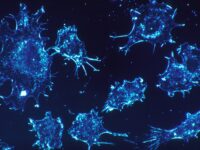Parkinson’s disease, the second most common neurodegenerative disease, is characterized by the gradual loss of dopaminergic (dopamine-producing) neurons, leading to motor symptoms including stiffness, slowness of movements, and involuntary tremors. Parkinson’s can also present nonmotor symptoms such as digestive issues and sleep deficits. Unfortunately, there is currently no effective therapy that can delay or stop the progression of the disease.
In recent years, researchers have been exploring the connection between Parkinson’s and circadian rhythms. Circadian rhythms drive many behavioral and physiological processes including the sleep-wake cycle, feeding behavior, body temperature, and more. They are crucial to an individual’s homeostasis, or steady physiological equilibrium.
Parkinson’s disease is frequently accompanied by disrupted sleep and circadian rhythms. These issues typically appear before motor symptoms, suggesting that a disrupted circadian rhythm could contribute to the disease’s development. A 2023 review by Priya Rathor and Ratnasekhar Ch proposed that circadian rhythms influence the expression of genes involved in neural activity and synaptic plasticity. This association could explain why disruption of the circadian rhythm increases the risk or extent of neurodegeneration associated with Parkinson’s disease.
The current challenge for scientists today is to uncover the exact relationship between circadian rhythms and Parkinson’s disease. Michaëla Dorcikova from the University of Geneva led a study exploring neurodegeneration in male fruit flies. It has previously been shown that disruption of a fly’s circadian rhythm can lead to lifespan reduction and even increased mortality in response to oxidative stress. Oxidative stress occurs as a result of imbalanced chemical activity in the body, leading to damaged tissue or disease. Researchers can use oxidative stress to learn more about how the body reacts to disrupted circadian behavior, especially in conjunction with neurodegeneration.
“[Dorcikova’s] study is remarkable because it suggests that not only is there a correlation between circadian rhythms and dopaminergic neurodegeneration, but perhaps also a causal relationship.”
Dorcikova and her team used fruit flies as models of the human brain with Parkinson’s disease. They noticed that functional impairments or a loss of dopaminergic neurons were frequently seen in a nerve cluster called PAM neurons. Upon further examination, they found that the loss of the circadian clock gene per exacerbates the loss of dopaminergic neurons in the PAM cluster. This is because per typically regulates the sensitivity of PAM neurons to oxidative stress. If this gene isn’t functional, the neurons’ vulnerability can be altered, leading to changes in sleep that are frequently observed in Parkinson’s. This study suggests that not only is there a correlation between circadian rhythms and dopaminergic neurodegeneration, but perhaps also a causal relationship.
Other researchers are interested in the phenotype of individuals who have Parkinson’s disease, rather than the molecular processes in the brain. Massimo Marano and his team from the Università Campus Bio-Medico di Roma investigated the relationship between chronotype, daytime motor activity, and disease phenotype. Chronotype, a key aspect of circadian behavior, is the body’s natural inclination to sleep and wake at certain times of the day.
One of the major findings from Marano’s lab was an association between the moderate morning and intermediate chronotypes and a typical Parkinson’s phenotype. Individuals with these chronotypes tended to struggle with more significant axial motor impairment and motor fluctuations, as well as a generally decreased quality of life. The intermediate group, which is usually considered an evening chronotype, showed more widespread impairment in regard to motor complications and quality of life. This result implies that people who prefer to be more active in the evening and sleep and wake up late may develop more extreme Parkinson’s symptoms.
“This result implies that those with evening chronotypes may develop more extreme Parkinson’s phenotypes.”
Studies like Dorcikova’s and Marano’s help establish connections between circadian rhythms and the progression and severity of Parkinson’s disease. While researchers understand that they are related, more work will need to be done to determine the exact role that circadian behavior plays in the disease’s development. Since sleep deficits and other related circadian disruptions are frequently associated with Parkinson’s, these and other findings create a better understanding of the disease and its risk factors, as well as insights into possible treatments.






